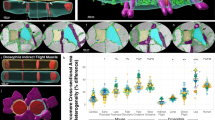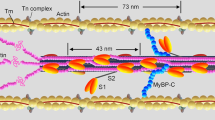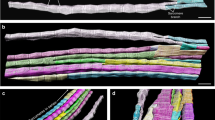Abstract
Correct specification of myofilament length is essential for efficient skeletal muscle contraction. The length of thin actin filaments can be explained by a novel 'two-segment' model, wherein the thin filaments consist of two concatenated segments, which are of either constant or variable length. This is in contrast to the classic 'nebulin ruler' model, which postulates that thin filaments are uniform structures, the lengths of which are dictated by nebulin. The two-segment model implicates position-specific microregulation of actin dynamics as a general principle underlying actin filament length and stability.
This is a preview of subscription content, access via your institution
Access options
Subscribe to this journal
Receive 12 print issues and online access
$189.00 per year
only $15.75 per issue
Buy this article
- Purchase on Springer Link
- Instant access to full article PDF
Prices may be subject to local taxes which are calculated during checkout


Similar content being viewed by others
References
Pollard, T. D. & Cooper, J. A. Actin, a central player in cell shape and movement. Science 326, 1208–1212 (2009).
Fowler, V. M. Regulation of actin filament length in erythrocytes and striated muscle. Curr. Opin. Cell Biol. 8, 86–96 (1996).
Mooseker, M. S. Organization, chemistry, and assembly of the cytoskeletal apparatus of the intestinal brush border. Annu. Rev. Cell Biol. 1, 209–241 (1985).
Tilney, L. G., Tilney, M. S. & DeRosier, D. J. Actin filaments, stereocilia, and hair cells: how cells count and measure. Annu. Rev. Cell Biol. 8, 257–274 (1992).
Huxley, H. & Hanson, J. Changes in the cross-striations of muscle during contraction and stretch and their structural interpretation. Nature 173, 973–976 (1954).
Huxley, A. F. & Niedergerke, R. Structural changes in muscle during contraction; interference microscopy of living muscle fibres. Nature 173, 971–973 (1954).
Granzier, H. L., Akster, H. A. & Ter Keurs, H. E. Effect of thin filament length on the force–sarcomere length relation of skeletal muscle. Am. J. Physiol. 260, C1060–C1070 (1991).
Walker, S. M. & Schrodt, G. R. I segment lengths and thin filament periods in skeletal muscle fibers of the rhesus monkey and the human. Anat. Rec. 178, 63–81 (1974).
Edman, K. A. The relation between sarcomere length and active tension in isolated semitendinosus fibres of the frog. J. Physiol. 183, 407–417 (1966).
Gordon, A. M., Huxley, A. F. & Julian, F. J. The variation in isometric tension with sarcomere length in vertebrate muscle fibres. J. Physiol. 184, 170–192 (1966).
Littlefield, R. S. & Fowler, V. M. Thin filament length regulation in striated muscle sarcomeres: pointed-end dynamics go beyond a nebulin ruler. Semin. Cell Dev. Biol. 19, 511–519 (2008).
Nyland, L. R. et al. Cardiac myosin binding protein-C is essential for thick-filament stability and flexural rigidity. Biophys. J. 96, 3273–3280 (2009).
Cripps, R. M., Suggs, J. A. & Bernstein, S. I. Assembly of thick filaments and myofibrils occurs in the absence of the myosin head. EMBO J. 18, 1793–1804 (1999).
Margossian, S. S., Huiatt, T. W. & Slayter, H. S. Control of filament length by the regulatory light chains in skeletal and cardiac myosins. J. Biol. Chem. 262, 5791–5796 (1987).
Suggs, J. A. et al. Alternative S2 hinge regions of the myosin rod differentially affect muscle function, myofibril dimensions and myosin tail length. J. Mol. Biol. 367, 1312–1329 (2007).
Hanson, J. & Lowy, J. The structure of F-actin and of actin filaments isolated from muscle. J. Mol. Biol. 6, 46–60 (1963).
Oosawa, F. & Asakura, S. Thermodynamics of the polymerization of protein. (Academic Press, 1975).
Littlefield, R. & Fowler, V. M. Defining actin filament length in striated muscle: rulers and caps or dynamic stability? Annu. Rev. Cell Dev. Biol. 14, 487–525 (1998).
Casella, J. F., Craig, S. W., Maack, D. J. & Brown, A. E. Cap Z(36/32), a barbed end actin-capping protein, is a component of the Z-line of skeletal muscle. J. Cell Biol. 105, 371–379 (1987).
Hart, M. C. & Cooper, J. A. Vertebrate isoforms of actin capping protein-β have distinct functions in vivo. J. Cell Biol. 147, 1287–1298 (1999).
Schafer, D. A., Hug, C. & Cooper, J. A. Inhibition of CapZ during myofibrillogenesis alters assembly of actin filaments. J. Cell Biol. 128, 61–70 (1995).
Schafer, D. A., Korshunova, Y. O., Schroer, T. A. & Cooper, J. A. Differential localization and sequence analysis of capping protein β-subunit isoforms of vertebrates. J. Cell Biol. 127, 453–465 (1994).
Cooper, J. A. & Sept, D. New insights into mechanism and regulation of actin capping protein. Int. Rev. Cell Mol. Biol. 267, 183–206 (2008).
Gokhin, D. S. et al. Thin-filament length correlates with fiber type in human skeletal muscle. Am. J. Physiol. Cell Physiol. 302, C555–C565 (2012).
Gokhin, D. S. et al. Tropomodulin isoforms regulate thin filament pointed-end capping and skeletal muscle physiology. J. Cell Biol. 189, 95–109 (2010).
Fowler, V. M., Sussmann, M. A., Miller, P. G., Flucher, B. E. & Daniels, M. P. Tropomodulin is associated with the free (pointed) ends of the thin filaments in rat skeletal muscle. J. Cell Biol. 120, 411–420 (1993).
Almenar-Queralt, A., Lee, A., Conley, C. A., Ribas de Pouplana, L. & Fowler, V. M. Identification of a novel tropomodulin isoform, skeletal tropomodulin, that caps actin filament pointed ends in fast skeletal muscle. J. Biol. Chem. 274, 28466–28475 (1999).
Gokhin, D. S. & Fowler, V. M. Tropomodulin capping of actin filaments in striated muscle development and physiology. J. Biomed. Biotechnol. 2011, 103069 (2011).
Littlefield, R., Almenar-Queralt, A. & Fowler, V. M. Actin dynamics at pointed ends regulates thin filament length in striated muscle. Nature Cell Biol. 3, 544–551 (2001).
Gregorio, C. C., Weber, A., Bondad, M., Pennise, C. R. & Fowler, V. M. Requirement of pointed-end capping by tropomodulin to maintain actin filament length in embryonic chick cardiac myocytes. Nature 377, 83–86 (1995).
Bai, J., Hartwig, J. H. & Perrimon, N. SALS, a WH2- domain-containing protein, promotes sarcomeric actin filament elongation from pointed ends during Drosophila muscle growth. Dev. Cell 13, 828–842 (2007).
Mardahl-Dumesnil, M. & Fowler, V. M. Thin filaments elongate from their pointed ends during myofibril assembly in Drosophila indirect flight muscle. J. Cell Biol. 155, 1043–1053 (2001).
Mudry, R. E., Perry, C. N., Richards, M., Fowler, V. M. & Gregorio, C. C. The interaction of tropomodulin with tropomyosin stabilizes thin filaments in cardiac myocytes. J. Cell Biol. 162, 1057–1068 (2003).
Weber, A., Pennise, C. R., Babcock, G. G. & Fowler, V. M. Tropomodulin caps the pointed ends of actin filaments. J. Cell Biol. 127, 1627–1635 (1994).
Weber, A., Pennise, C. R. & Fowler, V. M. Tropomodulin increases the critical concentration of barbed end-capped actin filaments by converting ADP•Pi-actin to ADP-actin at all pointed filament ends. J. Biol. Chem. 274, 34637–34645 (1999).
Broschat, K. O. Tropomyosin prevents depolymerization of actin filaments from the pointed end. J. Biol. Chem. 265, 21323–21329 (1990).
Broschat, K. O., Weber, A. & Burgess, D. R. Tropomyosin stabilizes the pointed end of actin filaments by slowing depolymerization. Biochemistry 28, 8501–8506 (1989).
Ono, S. Dynamic regulation of sarcomeric actin filaments in striated muscle. Cytoskeleton 67, 677–692 (2010).
Yamashiro, S., Gokhin, D. S., Kimura, S., Nowak, R. B. & Fowler, V. M. Tropomodulins: pointed-end capping proteins that regulate actin filament architecture in diverse cell types. Cytoskeleton 69, 337–370 (2012).
Pappas, C. T., Bliss, K. T., Zieseniss, A. & Gregorio, C. C. The nebulin family: an actin support group. Trends Cell Biol. 21, 29–37 (2011).
McElhinny, A. S., Kolmerer, B., Fowler, V. M., Labeit, S. & Gregorio, C. C. The N-terminal end of nebulin interacts with tropomodulin at the pointed ends of the thin filaments. J. Biol. Chem. 276, 583–592 (2001).
Pappas, C. T., Bhattacharya, N., Cooper, J. A. & Gregorio, C. C. Nebulin interacts with CapZ and regulates thin filament architecture within the Z-disc. Mol. Biol. Cell 19, 1837–1847 (2008).
Kruger, M., Wright, J. & Wang, K. Nebulin as a length regulator of thin filaments of vertebrate skeletal muscles: correlation of thin filament length, nebulin size, and epitope profile. J. Cell Biol. 115, 97–107 (1991).
Labeit, S. et al. Evidence that nebulin is a protein-ruler in muscle thin filaments. FEBS Lett. 282, 313–316 (1991).
Castillo, A., Nowak, R., Littlefield, K. P., Fowler, V. M. & Littlefield, R. S. A nebulin ruler does not dictate thin filament lengths. Biophys. J. 96, 1856–1865 (2009).
Littlefield, R. & Fowler, V. M. Measurement of thin filament lengths by distributed deconvolution analysis of fluorescence images. Biophys. J. 82, 2548–2564 (2002).
Ochala, J. et al. Congenital myopathy-causing tropomyosin mutations induce thin filament dysfunction via distinct physiological mechanisms. Hum. Mol. Genet. 21, 4473–4485 (2012).
Ringkob, T. P., Swartz, D. R. & Greaser, M. L. Light microscopy and image analysis of thin filament lengths utilizing dual probes on beef, chicken, and rabbit myofibrils. J. Anim. Sci. 82, 1445–1453 (2004).
Buck, D., Hudson, B. D., Ottenheijm, C. A., Labeit, S. & Granzier, H. Differential splicing of the large sarcomeric protein nebulin during skeletal muscle development. J. Struct. Biol. 170, 325–333 (2010).
Millevoi, S. et al. Characterization of nebulette and nebulin and emerging concepts of their roles for vertebrate Z-discs. J. Mol. Biol. 282, 111–123 (1998).
Bang, M. L. et al. Nebulin-deficient mice exhibit shorter thin filament lengths and reduced contractile function in skeletal muscle. J. Cell Biol. 173, 905–916 (2006).
Moncman, C. L. & Wang, K. Nebulette: a 107 kD nebulin-like protein in cardiac muscle. Cell Motil. Cytoskeleton 32, 205–225 (1995).
Moncman, C. L. & Wang, K. Targeted disruption of nebulette protein expression alters cardiac myofibril assembly and function. Exp. Cell Res. 273, 204–218 (2002).
Pappas, C. T., Krieg, P. A. & Gregorio, C. C. Nebulin regulates actin filament lengths by a stabilization mechanism. J. Cell Biol. 189, 859–870 (2010).
Witt, C. C. et al. Nebulin regulates thin filament length, contractility, and Z-disk structure in vivo. EMBO J. 25, 3843–3855 (2006).
Gokhin, D. S., Bang, M. L., Zhang, J., Chen, J. & Lieber, R. L. Reduced thin filament length in nebulin-knockout skeletal muscle alters isometric contractile properties. Am. J. Physiol. Cell Physiol. 296, C1123–C1132 (2009).
Galkin, V. E., Orlova, A., Schroder, G. F. & Egelman, E. H. Structural polymorphism in F-actin. Nature Struct. Mol. Biol. 17, 1318–1323 (2010).
Sussman, M. A. et al. Altered expression of tropomodulin in cardiomyocytes disrupts the sarcomeric structure of myofibrils. Circ. Res. 82, 94–105 (1998).
Gokhin, D. S. & Fowler, V. M. Cytoplasmic γ-actin and tropomodulin isoforms link to the sarcoplasmic reticulum in skeletal muscle fibers. J. Cell Biol. 194, 105–120 (2011).
Gokhin, D. S. & Fowler, V. M. The sarcoplasmic reticulum: actin and tropomodulin hit the links. Bioarchitecture 1, 175–179 (2011).
Tsukada, T. et al. Leiomodin-2 is an antagonist of tropomodulin-1 at the pointed end of the thin filaments in cardiac muscle. J. Cell Sci. 123, 3136–3145 (2010).
Chereau, D. et al. Leiomodin is an actin filament nucleator in muscle cells. Science 320, 239–243 (2008).
Kontrogianni-Konstantopoulos, A., Ackermann, M. A., Bowman, A. L., Yap, S. V. & Bloch, R. J. Muscle giants: molecular scaffolds in sarcomerogenesis. Physiol. Rev. 89, 1217–1267 (2009).
Katzemich, A. et al. The function of the M-line protein, obscurin, in controlling the symmetry of the sarcomere in Drosophila flight muscle. J. Cell Sci. 125, 3367–3379 (2012).
Lange, S. et al. Obscurin determines the architecture of the longitudinal sarcoplasmic reticulum. J. Cell Sci. 122, 2640–2650 (2009).
Skwarek-Maruszewska, A., Hotulainen, P., Mattila, P. K. & Lappalainen, P. Contractility-dependent actin dynamics in cardiomyocyte sarcomeres. J. Cell Sci. 122, 2119–2126 (2009).
Ramachandran, I., Terry, M. & Ferrari, M. B. Skeletal muscle myosin cross-bridge cycling is necessary for myofibrillogenesis. Cell Motil. Cytoskeleton 55, 61–72 (2003).
Kagawa, M., Sato, N. & Obinata, T. Effects of BTS (N-benzyl-p-toluene sulphonamide), an inhibitor for myosin-actin interaction, on myofibrillogenesis in skeletal muscle cells in culture. Zool. Sci. 23, 969–975 (2006).
Soeno, Y., Shimada, Y. & Obinata, T. BDM (2,3-butanedione monoxime), an inhibitor of myosin-actin interaction, suppresses myofibrillogenesis in skeletal muscle cells in culture. Cell Tissue Res. 295, 307–316 (1999).
Wallgren-Pettersson, C., Sewry, C. A., Nowak, K. J. & Laing, N. G. Nemaline myopathies. Semin. Pediatr. Neurol. 18, 230–238 (2011).
Ottenheijm, C. A. et al. Thin filament length dysregulation contributes to muscle weakness in nemaline myopathy patients with nebulin deficiency. Hum. Mol. Genet. 18, 2359–2369 (2009).
Ottenheijm, C. A. et al. Altered myofilament function depresses force generation in patients with nebulin-based nemaline myopathy (NEM2). J. Struct. Biol. 170, 334–343 (2010).
Telfer, W. R., Nelson, D. D., Waugh, T., Brooks, S. V. & Dowling, J. J. Neb: a zebrafish model of nemaline myopathy due to nebulin mutation. Dis. Model. Mech. 5, 389–396 (2012).
Marston, S. B. & Hodgkinson, J. L. Cardiac and skeletal myopathies: can genotype explain phenotype? J. Muscle Res. Cell Motil. 22, 1–4 (2001).
Agrawal, P. B. et al. Nemaline myopathy with minicores caused by mutation of the CFL2 gene encoding the skeletal muscle actin-binding protein, cofilin-2. Am. J. Hum. Genet. 80, 162–167 (2007).
Ockeloen, C. W. et al. Congenital myopathy caused by a novel missense mutation in the CFL2 gene. Neuromuscul. Disord. 22, 632–639 (2012).
Ochala, J. et al. Disrupted myosin cross-bridge cycling kinetics triggers muscle weakness in nebulin-related myopathy. FASEB J. 25, 1903–1913 (2011).
Bang, M. L. et al. Nebulin plays a direct role in promoting strong actin-myosin interactions. FASEB J. 23, 4117–4125 (2009).
Ottenheijm, C. A. et al. Sarcoplasmic reticulum calcium uptake and speed of relaxation are depressed in nebulin-free skeletal muscle. FASEB J. 22, 2912–2919 (2008).
Chandra, M. et al. Nebulin alters cross-bridge cycling kinetics and increases thin filament activation: a novel mechanism for increasing tension and reducing tension cost. J. Biol. Chem. 284, 30889–30896 (2009).
Manor, U. & Kachar, B. Dynamic length regulation of sensory stereocilia. Semin. Cell Dev. Biol. 19, 502–510 (2008).
Nambiar, R., McConnell, R. E. & Tyska, M. J. Myosin motor function: the ins and outs of actin-based membrane protrusions. Cell. Mol. Life Sci. 67, 1239–1254 (2010).
Zhang, D. S. et al. Multi-isotope imaging mass spectrometry reveals slow protein turnover in hair-cell stereocilia. Nature 481, 520–524 (2012).
Page, S. G. & Huxley, H. E. Filament lengths in striated muscle. J. Cell Biol. 19, 369–390 (1963).
Burgoyne, T., Muhamad, F. & Luther, P. K. Visualization of cardiac muscle thin filaments and measurement of their lengths by electron tomography. Cardiovasc. Res. 77, 707–712 (2008).
Acknowledgements
Work in the authors laboratory was supported by the US National Institutes of Health (NIH) grants R01-HL083464 and P30-AR061303 (to V.M.F.) and a development grant from the Muscular Dystrophy Association (to D.S.G.).
Author information
Authors and Affiliations
Corresponding author
Ethics declarations
Competing interests
The authors declare no competing financial interests.
Related links
Rights and permissions
About this article
Cite this article
Gokhin, D., Fowler, V. A two-segment model for thin filament architecture in skeletal muscle. Nat Rev Mol Cell Biol 14, 113–119 (2013). https://doi.org/10.1038/nrm3510
Published:
Issue Date:
DOI: https://doi.org/10.1038/nrm3510
This article is cited by
-
Expressing a Z-disk nebulin fragment in nebulin-deficient mouse muscle: effects on muscle structure and function
Skeletal Muscle (2020)
-
Nebulin: big protein with big responsibilities
Journal of Muscle Research and Cell Motility (2020)
-
Multifunctional roles of tropomodulin-3 in regulating actin dynamics
Biophysical Reviews (2018)
-
Resistance to radial expansion limits muscle strain and work
Biomechanics and Modeling in Mechanobiology (2017)



